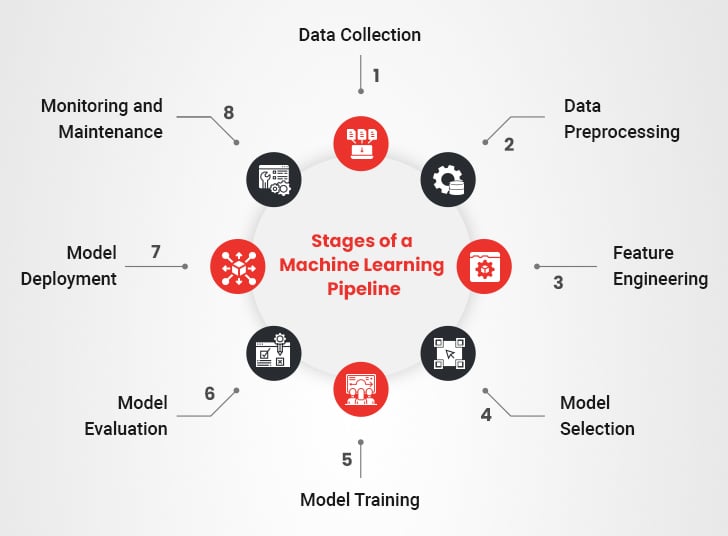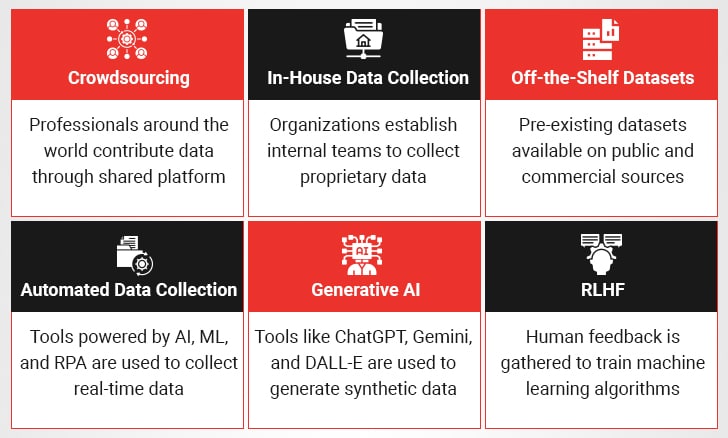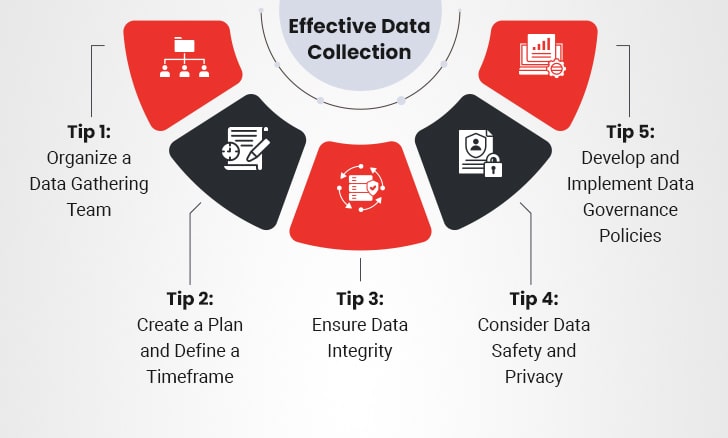Artificial intelligence (AI) is altering our lives and businesses for good by enhancing experiences and simplifying tasks. When did you last go to a bank to make deposits, transfer money, or for KYC? It is tough to recall, as AI has brought each of these processes right at your disposal, making them highly simplified and easily accessible. Take another example of autonomous vehicles. Once a marvelous plot of science fiction, driverless cars are a wonderful reality today.

Think of using filters while clicking photos and unlocking smartphones without entering a PIN or password. Other than this, AI is also making strides in healthcare. It facilitates robotic surgeries, detects anomalies in medical images, accelerates drug discovery, and transforms patient lives with wearable technology. The agriculture sector is no exception, as AI is used for precision cropping, weed detection, and sustainable farming.
As evident, businesses across industries and verticals are developing and adopting AI solutions to make their processes simple yet efficient. No wonder AI will exceed the USD 826 billion mark in 2030! But how are these AI-powered chatbots so human? How do cars drive themselves? Or how do simple devices detect anomalies and recognize objects? The answer is data, which enables machines to understand their environment and perform desired actions. And all this begins with a single step called data collection.
Table of Contents
Process at glance: Data collection
Types of data collected for AI/ML
Top data collection methods for AI and ML
Common challenges in AI data collection
Process at Glance: Data Collection
Data collection, the fundamental step in the machine learning pipeline, includes pooling data by scraping and capturing from multiple online and offline sources. The collected data is used to train and test AI/ML models. Take a look at the framework to better understand the role of data collection in the machine learning pipeline:

In short, AI/ML systems learn from structured and unstructured data gathered from various sources to mimic human actions and make decisions and predictions. Thus, it’s essential to ensure that the data collected is of the highest quality and complies with industry regulations.
As simple as it may seem, data collection is easier said than done, as the quality of data directly impacts the AI/ML model’s outcomes. Stakeholders must know the starting point of their data collection journey, which is, knowing what type of data to collect!
From Data to Decisions: How Data Collection Services Drive Business Impact:
Types of Data Collected for AI/ML
Data collection for AI/ML is a broader term wherein data can be anything, including text, images, videos, audio, or a mix of all these. In other words, anything that helps a machine perform actions and make decisions is data in this space.
Broadly speaking, datasets can be derived from structured and unstructured sources. Structured datasets have an explicit meaning and format and are easily comprehensible for machines. On the other hand, unstructured datasets don’t have any fixed structure or format. The human-in-the-loop approach is required to extract valuable insights from unstructured datasets.
Below are the different types of data used for training machine learning algorithms. Take a look:
I. Text Data
Text data is one of the prominent forms of data. Structured sources include online forms, databases, spreadsheets, medical devices, GPS navigation units, and more. Contrarily, unstructured text data includes handwritten documents, email responses, surveys, images of text, social media comments, etc. Applications such as chatbots, translation tools, and sentiment analysis rely heavily on textual datasets.
II. Image Data
Image data plays a pivotal role in computer vision tasks such as object detection, facial recognition, landmark identification, and medical imaging analysis. This type of data is collected from cameras, satellites, drones, digital archives, etc. High-resolution images with proper annotations ensure that machines interpret visual information accurately.
III. Audio Data
Audio data includes human speech, environmental sounds, audiovisual content, phone call recordings, musical compositions, and more. Training audio models often requires transcription and phonetic annotation to convert sounds to text and understand accents and pronunciation to address queries in multiple languages. Using this, businesses can develop more intelligent chatbots, and virtual assistants.
IV. Video Data
Video data extends the capabilities of AI/ML systems by integrating visual and audio information. This type of data can be sourced from computer vision, digital imaging, and more. In fact, video data annotation is the driving force behind autonomous vehicles and other CV-enabled technologies such as security surveillance and facial recognition.
By combining these data types, organizations create multi-modal datasets that enhance model capabilities, leading to comprehensive solutions that drive agility and efficiency within business processes. Thus, the next important question is how to collect data for AI.
Top Data Collection Methods for AI and ML
There are multiple ways to gather data, and knowing the right method is essential to make the entire process fruitful. While some companies resort to professional data collection services as a cost-effective way to get high-quality data, others gather data independently using various tools and methods. Some of the key techniques include:

1) Crowdsourcing
Crowdsourcing involves engaging a large group of individuals to contribute data through a shared platform. This method offers a wide variety of data since the data is gathered from across the globe. Moreover, crowdsourcing effectively gathers both primary and secondary data, ranging from academic research data to user-generated content. Businesses can easily eliminate the cost associated with hiring data collection professionals and equipment. The only drawback of this method is that data quality becomes difficult to track since many contributors work remotely.
2) In-House Data Collection
Organizations may establish in-house teams to gather proprietary datasets tailored to their unique needs. While resource-intensive, this method ensures greater control over data quality, integrity, and alignment with project objectives. This method is most effective when the dataset requirement is small or the data is highly sensitive. And, if the problem statement is precisely defined, in-house data collection works the best.
3) Off-the-Shelf Datasets
Pre-existing datasets, available from public or commercial sources, provide a cost-effective solution for data collection. This is ideal for projects when the requirements aren’t too specific and require a wide range of data. An image recognition system, for instance, can be fed with off-the-shelf datasets. Majorly, prepackaged datasets meet 70-80% of the project requirements; however, the remaining 20-30% data gap can be challenging. Though this option may be affordable initially, the data gaps prove costlier in the long run as resources are required to fill these.
4) Automated Data Collection
Web data collection through automated tools like web crawlers and APIs enables organizations to retrieve large volumes of publicly available data. Automated data collection is synonymous with agility, efficiency, and scalability, as these tools combine AI, ML, and RPA with human expertise. It is the most efficient tool for primary and secondary data collection, which also eliminates the chances of human errors. What sets this approach apart is its ability to gather real-time data. At the same time, maintaining automated tools proves costly, especially for companies with a budget crunch, and requires compliance with legal and ethical standards.
5) Generative AI
The hottest topic of every boardroom meeting, Generative AI models, such as GPT, can synthesize new data based on existing patterns. This method is particularly useful for creating synthetic datasets in scenarios with scarce or sensitive real-world data. The data generated through this method can be in the form of text, images, videos, audio, etc. Besides synthesizing data, Generative AI helps with data augmentation and simulation of missing scenarios.
The only loophole of this approach is that the generated data might not accurately represent real-world scenarios. Simply put, the ML model might perform well with synthetic data but fails to respond aptly when presented with real-world challenges.
6) Reinforcement Learning from Human Feedback (RLHF)
RLHF integrates human expertise into the training loop by refining model predictions based on user feedback. This iterative process enhances the quality and relevance of training datasets, ensuring models align with real-world expectations. On the flip side, relying on human feedback is not only time-consuming but also makes it difficult to scale in the case of large applications. Moreover, human biases might be introduced to the AI/ML algorithms, leading to wrong decisions. In worst-case scenarios, this might widen the societal gap.
As evident, each method contributes to building a robust data pipeline, accelerating the development of AI/ML solutions. However, the data collection process is riddled with challenges such as cleaning and processing, privacy and ethical considerations, biases, and more.
Exploring AI’s Impact on Data Collection Companies:
Common Challenges in Data Collection
Data collection for AI and ML is a complicated task. To ensure accurate and reliable outcomes, businesses must collect large volumes of diversified data. That said, collecting sheer volumes and variety of data is challenging. And even if businesses manage to gather such data, storage is an issue.
Other than this, multiple other challenges prevent organizations from training and developing reliable AI models. And all these issues must be addressed as a priority to accelerate the development process.
Some of the common roadblocks on a company’s path to AI training and development include:
A. Data Processing and Cleaning
Data collected from diverse sources is raw in nature and full of inconsistencies, redundancies, and errors. Thus, this data cannot be used to train machine learning models. It must be cleansed and processed to help the algorithms understand the data easily. That said, data cleaning removes duplicates, fills missing values, and standardizes formats, while processing ensures the quality and usability of datasets.
B. Labeling Data
This is challenging in the context of supervised machine learning. Manual labeling is time-consuming and prone to human error. Any inaccuracy or inconsistency in the labels impacts the ML model’s performance. Businesses can leverage automated labeling tools and active learning to alleviate this issue. However, a human-in-the-loop approach is necessary to ensure the accuracy of such tasks.
C. Privacy and Ethical Considerations
Data collection raises concerns about user privacy and compliance with regulations such as GDPR, CCPA, and HIPAA (in the case of healthcare data). Organizations must obtain consent from individuals and anonymize personal information to prevent unauthorized access or data breaches. Ethical considerations should also be taken into account to prevent harm or discriminatory behavior from collecting and using data.
D. Addressing Bias
Bias in training data leads to skewed AI predictions, reinforcing stereotypes or excluding specific demographics. Collecting diverse and representative datasets is important in developing fair and inclusive AI models. Businesses should also perform regular audits and check datapoints that aren’t well-represented or maintained in the datasets.
As evident, overcoming the above-mentioned challenges requires a combination of technical expertise, robust tools, and adherence to ethical guidelines. And partnering with a reliable data collection company is the smart way to easily access high-quality and regulatory-compliant data. However, companies gathering data on their own must know the tips that make the entire process effective and result-oriented.
Proven Tips for Effective Data Collection

To optimize the data collection process, organizations should adopt the following best practices:
- Organize a Data Gathering Team: Establish a dedicated team of data scientists, engineers, and domain experts to oversee the data collection process. Collaboration ensures the alignment of objectives and execution.
- Create a Plan and Define a Timeframe: Outline a detailed roadmap that specifies data sources, collection methods, and milestones. Setting a clear timeframe ensures timely completion and resource allocation.
- Ensure Data Integrity: Implement quality checks at every stage to maintain the accuracy, completeness, and reliability of datasets. Regular audits and validation techniques are instrumental.
- Consider Data Safety and Privacy: Adopt robust encryption protocols and access controls to safeguard sensitive information. Comply with relevant data protection regulations to minimize risks.
- Develop and Implement Data Governance Policies: Establish governance frameworks that define roles, responsibilities, and accountability for data management. Policies should address data lifecycle, access, and retention.
By adhering to these tips, organizations can streamline their data collection initiatives, ensuring consistency and efficiency.
Closing Thoughts
The rapid evolution of AI and ML lies in the availability of high-quality datasets. And data collection services play a critical role in accelerating innovations by providing the foundational resources needed for training intelligent algorithms. From text and image data to advanced methodologies like RLHF, the spectrum of data collection strategies is vast and diverse. Nonetheless, organizations must navigate challenges such as scalability, privacy concerns, and bias mitigation to ensure the success of their projects. By adopting best practices and implementing governance frameworks, businesses can leverage data collection to unlock transformative AI/ML solutions. And as the demand for AI/ML applications continues to grow, the importance of data collection will only increase.





